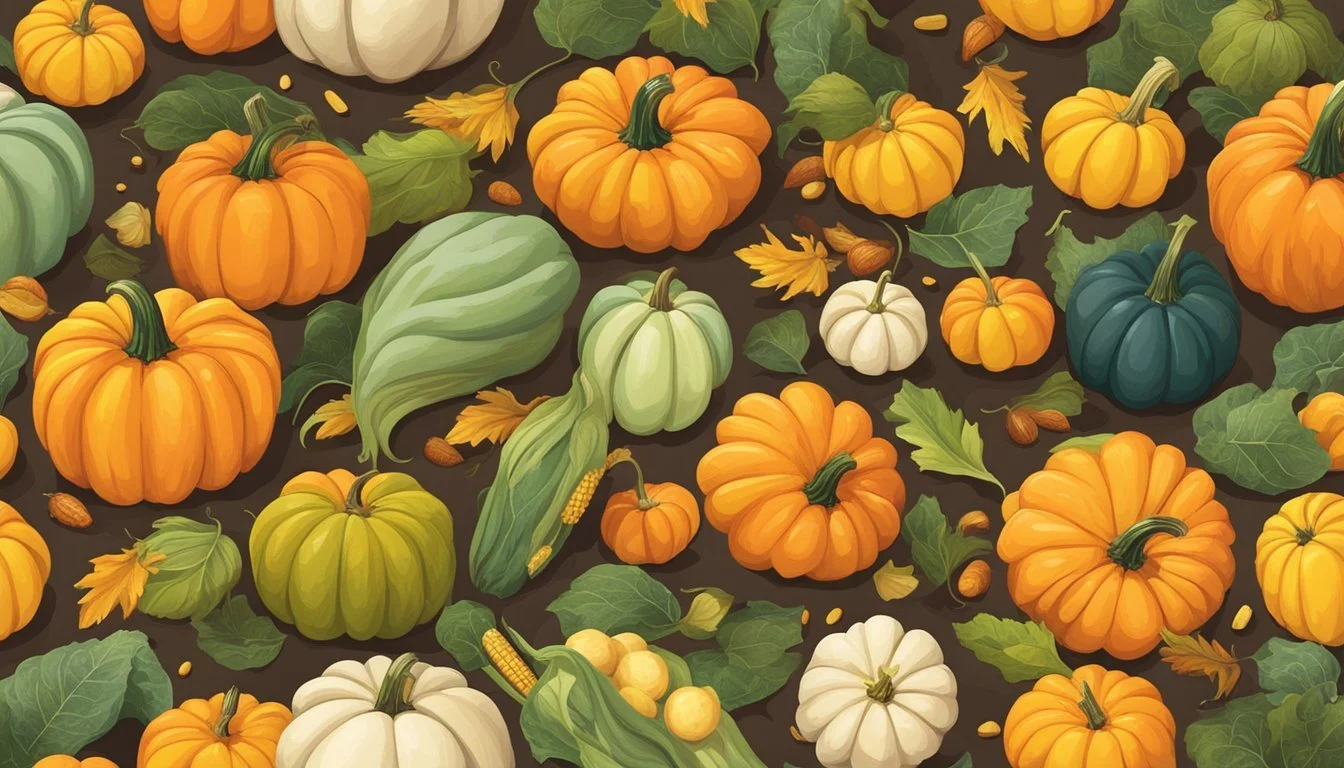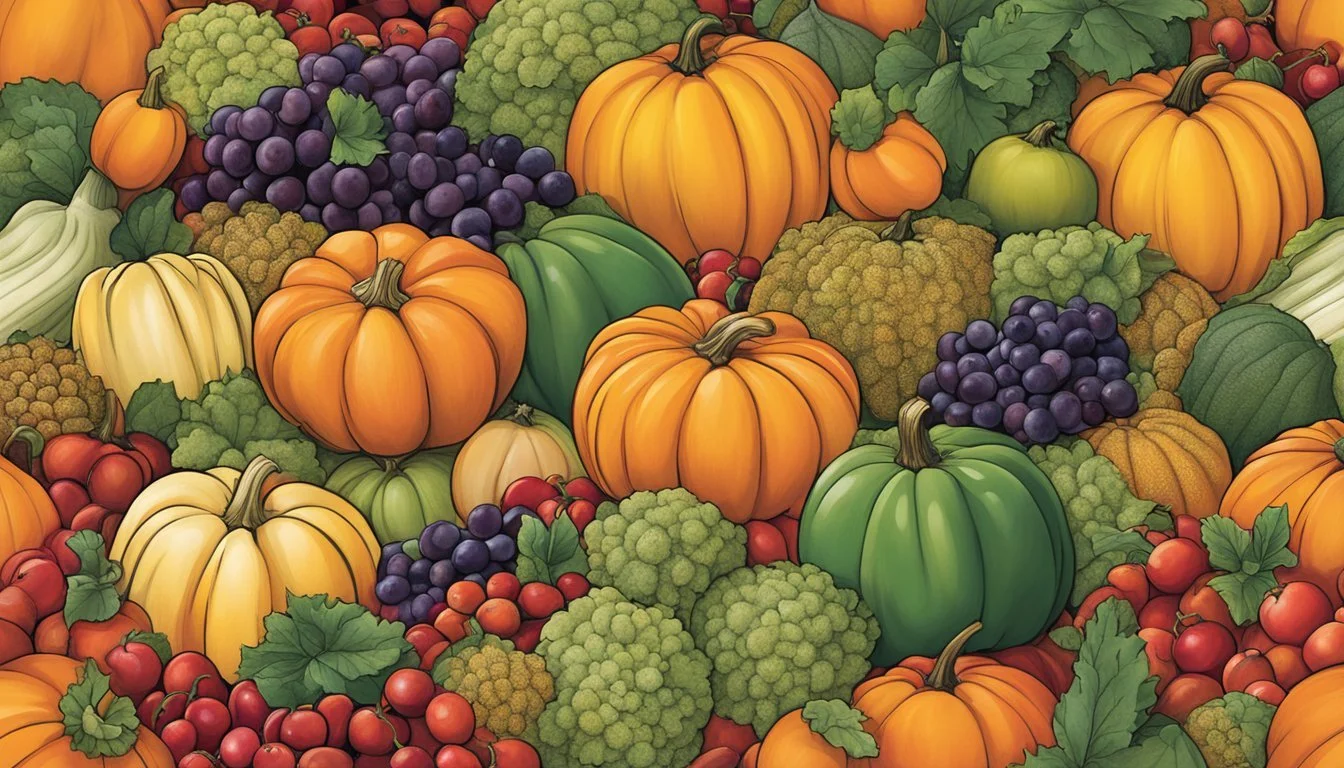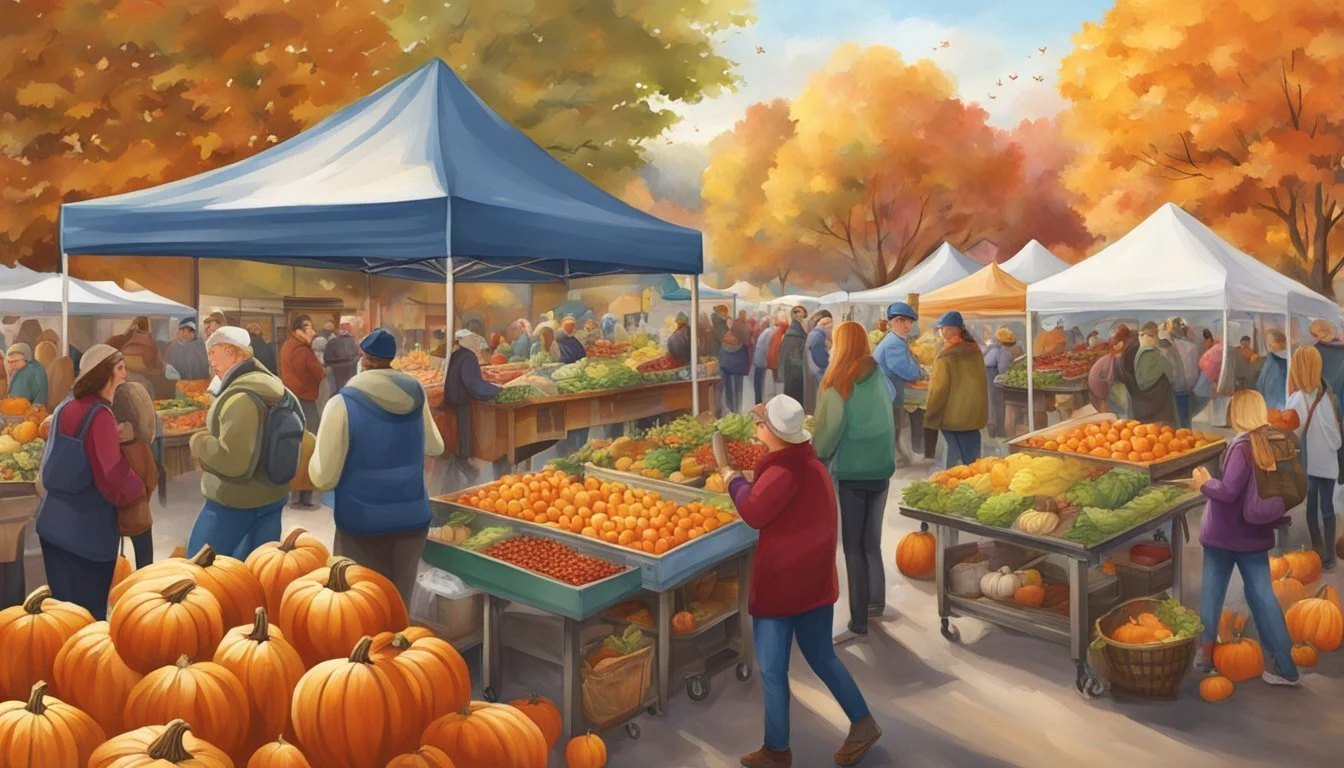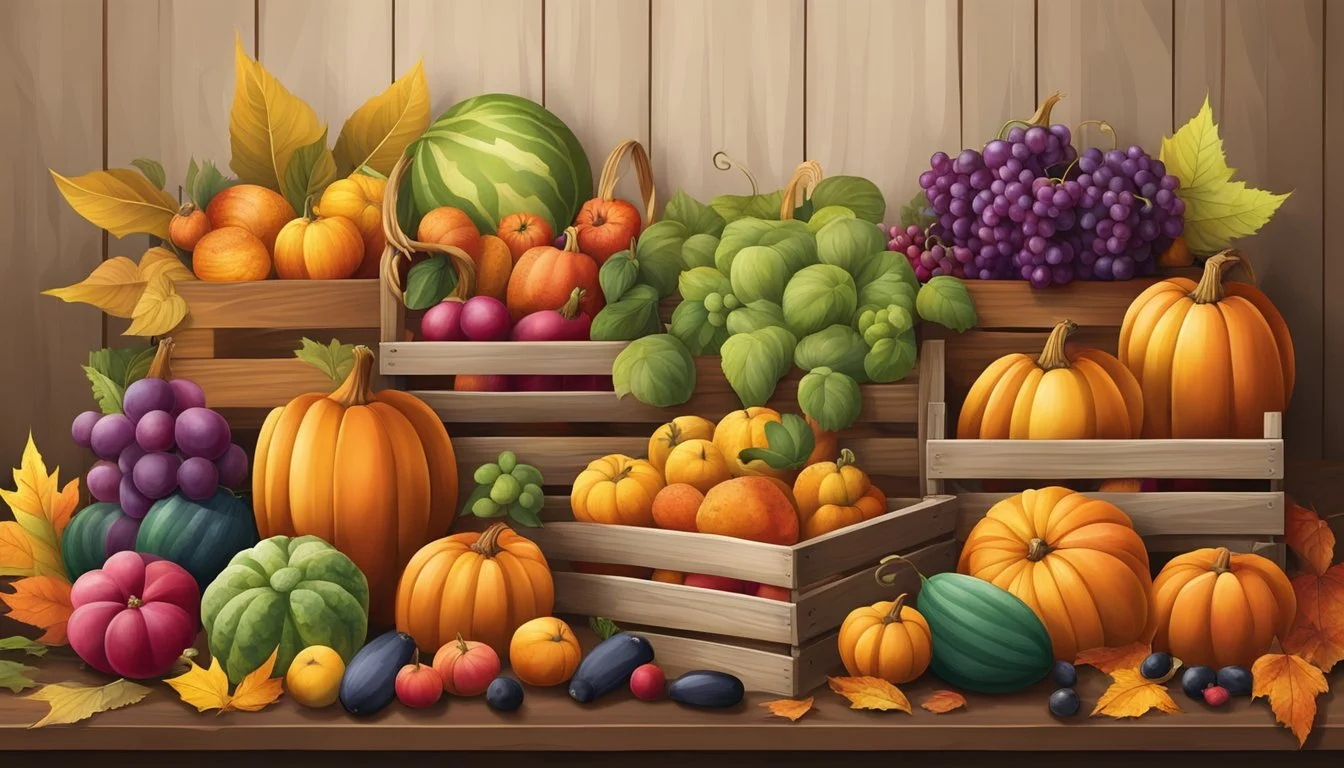Massachusetts Seasonal Fruit & Vegetables in October
Your Freshest Picks Guide
This Article is Part of our Massachusetts Seasonal Fruit & Veg Calendar
In Massachusetts, the arrival of October heralds a bounty of seasonal fruits and vegetables that reflect the state's harvest traditions and agricultural diversity. The crisp New England air and shorter days provide the perfect conditions for a variety of produce to reach its peak. Orchards celebrate the apple season with a multitude of varieties, including Ida Red, Rome, Red Delicious, Golden Delicious, and a host of others, offering an exceptional range quality-wise, as local farmers markets brim with the rich, earthy colors of fall's harvest.
The vegetable patches yield hardy greens and root vegetables. Massachusetts-grown pumpkins, corn, and potatoes are at their best, lending themselves to the heartwarming dishes characteristic of autumn. Green and snap peas, arugula, beets (how long do beets last?), and cauliflower also continue from their earlier seasons, complementing the quintessential fall selection.
This seasonal transition provides consumers with the opportunity to support local agriculture and benefit from the nutritional abundance of October's harvest. The cooler temperatures don’t just signal the changing leaves but also signal a shift in the palate from the light, refreshing flavors of summer to the comforting, robust profiles of fall's offerings.
Seasonal Availability
In October, Massachusetts' harvest season is in full swing, offering a bounty of fresh and local produce. The cooler temperatures and early frosts characterize a month rich in both fruit and vegetables.
Fruits: Apples claim the spotlight in October, with varieties like Ida Red, Rome, Red Delicious, Golden Delicious, and Northern Spy readily available. Pumpkins, synonymous with autumn and festive activities, are also at their prime.
Vegetables: Root vegetables such as turnips, carrots (how long do carrots last?), and beets are abundant due to their tolerance to the cooling weather. Leafy greens like kale and Swiss chard are still fresh, along with broccoli (how long does broccoli last?)and Brussels sprouts (how long do brussels sprouts last?) that thrive in the brisk environment. Potatoes continue their season, notably the hearty late-season varieties.
The following table summarizes the seasonal availability of common produce in October:
Type Produce Fruits Apples, Pumpkins Vegetables Turnips, Carrots, Beets, Kale, Swiss Chard, Broccoli, Brussels Sprouts, Potatoes
Residents are encouraged to visit local farmer's markets to support Massachusetts farmers and to enjoy the array of fresh, seasonal produce that October has to offer.
Prime Harvests of October
The month of October in Massachusetts is a prominent time for harvesting a variety of fruits and vegetables. The autumn climate allows for the full maturation and rich flavors of the seasonal produce.
Fruits in Season
Apples: A staple of the New England fall, varieties like McIntosh, Honey Crisp, Red Delicious, and Golden Delicious are ripe for picking.
Pumpkins: Integral to autumn festivities, they are in their prime, both for culinary uses and decoration.
Pears: The cooler weather allows for sweet and juicy harvests.
Cranberries: October is the peak time for harvesting cranberries, a fruit synonymous with Massachusetts.
Grapes: Cool-season grapes reach their peak flavor and sweetness.
Vegetables in Season
Brussels Sprouts: These thrive in the cooler temperatures of October and are best after the first frost.
Cabbage: Known for its versatility in dishes, cabbage is ready for harvest.
Kale: Cooler temperatures in October enhance the flavor of kale.
Leeks: They become sweet and tender during the fall season.
Spinach: The cool weather preserves the crisp texture and sweetness.
Pumpkin: Beyond the jack-o'-lantern, pumpkins are harvested for their flavorful flesh.
Unique Varieties and Where to Find Them
October in Massachusetts is a bountiful month, with harvests offering not just quantity but also a plethora of unique varieties. Local markets burst with color as the harvest times peak for certain produce. Apples and pumpkins are the iconic staples of this season, and visitors can find a diverse selection of these fall favorites.
Apples: Heirloom and special apple varieties such as Honeycrisp, Macoun, and Baldwin showcase the local orchards' pride. Seek these out at farmers' markets or at pick-your-own apple orchards across the state.
Local Orchards Apple Varieties Red Apple Farm Honeycrisp, Macoun Nashoba Valley Baldwin, Empire
Pumpkins: Beyond the classic round orange pumpkins, Massachusetts offers a range of pumpkin types, including the fairytale-esque Cinderella pumpkins and the peculiar, bumpy Knucklehead. Visit local pumpkin patches for the complete array.
Local Pumpkin Patches:
Pumpkin Hollow
Harvest Moon Farm
Farmers’ markets and roadside stands this time of year are prime spots for enthusiasts seeking both standard and unique produce varieties. They not only support local agriculture but also provide an avenue for consumers to explore the rich diversity of Massachusetts' October harvests.
Seasonal Recipes
In Massachusetts, October's bounty brings a wealth of ingredients into the kitchen, perfect for heartwarming recipes. Home cooks can take full advantage of autumn's flavors with dishes designed around pumpkins, apples, cranberries, squash, and root vegetables like beets and carrots.
Savory Dishes:
Roasted Vegetables: Beets and carrots, tossed with olive oil, salt, and pepper, and then roasted, make for a simple yet satisfying side dish.
Pumpkin Soup: Featuring the creaminess of pureed pumpkins, this soup is often enhanced with a touch of nutmeg and cinnamon for an extra cozy feel.
Squash Risotto: Butternut or delicata squash adds a sweet, nutty flavor to this creamy, comforting risotto.
Sweet Treats:
Apple Crisp: Tart apples like Granny Smith, topped with a crumbly oat mixture, offer a delightful contrast of textures and flavors when baked.
Cranberry Jam: The tartness of cranberries pairs well with sugar and orange zest, resulting in a jam that's excellent on toast or as a glaze for meats.
Salads:
Autumn Harvest Salad: A medley of roasted beets and carrots, mixed with fresh apples and cranberries, topped with a vinaigrette dressing.
Pumpkin Seed Spinach Salad: A nutrient-rich choice that includes roasted pumpkin seeds (how long do pumpkin seeds last?), a source of good fats, adding crunch to tender spinach leaves.
Preserves and Sauces:
Apple Sauce: Cooking down apples with a bit of cinnamon creates a versatile sauce that can complement both sweet and savory dishes.
Cranberry Sauce: A classic condiment that's integral to the New England fall experience, made by simmering cranberries with sugar and water until thickened.
When cooking with these ingredients, one appreciates the local harvest and the traditional flavors that characterize Massachusetts' October fare.
Health Benefits and Nutrition
In Massachusetts, the month of October is bountiful with various fruits and vegetables offering extensive health benefits. Consuming fresh, seasonal produce is not only more flavorful but also peaks in nutritional content.
Fruits such as apples and pumpkins are robust with vitamins and minerals. Apples are high in fiber, which aids in digestion and may contribute to lowering cholesterol levels. Pumpkins, while often classified as vegetables, provide a rich source of vitamin A, essential for eye health, and contain fibers that help to stabilize blood sugar levels.
Vegetables including sweet potatoes, butternut squash, and various greens are cultivated during this month. Sweet potatoes are a versatile root vegetable high in beta-carotene, vitamin C, and potassium. Butternut squash is another nutrient-dense option, supplying plenty of fiber, vitamin C, magnesium, and potassium.
Nutrient Benefits Fiber Supports digestive health and may lower the risk of heart disease. Vitamin A Essential for good vision and immune function. Vitamin C Necessary for the growth and repair of body tissues, aids in iron absorption. Potassium Helps to maintain normal blood pressure and muscle function.
Greens and beans, such as kale and cranberry beans, appear in the markets, each offering their unique nutritional profiles. Greens like kale are packed with vitamins A, C, and K, plus minerals such as calcium and iron. Beans, often overlooked, are excellent sources of plant-based protein and fiber, contributing to satiety and heart health.
Incorporating a variety of these seasonal fruits and vegetables into one's diet can lead to a well-rounded intake of essential nutrients, promoting overall health and wellness.
Agricultural Events and Festivals
In October, Massachusetts becomes a vibrant hub for agricultural events and festivities. The fall harvest is in full swing, inviting visitors and residents to partake in a variety of seasonal celebrations. One notable event is the Annual Pumpkin Fest, where pumpkins take center stage in a showcase of carving artistry and autumnal recipes.
Farmers' markets across the state brim with the season’s bounty, including a variety of apples from local orchards. These include events where attendees can enjoy apple picking alongside family-friendly activities such as hayrides and corn mazes. The Massachusetts Apple Harvest Festival celebrates everything from traditional apple pies to innovative apple-inspired dishes.
Harvest celebrations are common, with many farms opening their doors for community events. These celebrations often feature live music, craft vendors, and farm-to-table dining experiences focusing on October's harvest.
Here is a brief overview of some highlighted events:
Annual Pumpkin Fest: Pumpkins, carving contests, local crafts
Massachusetts Apple Harvest Festival: Apple picking, pie baking, cultural exhibits
Local Farmers' Markets: Fresh produce, October's harvest of fruits and vegetables, handmade local goods
It's not just about food; these festivals serve as a testament to the region's rich agricultural heritage, thereby providing educational opportunities for all ages on the importance of sustainable farming and local produce.
Supporting Local Agriculture
In October, as the leaves in Massachusetts adopt their brilliant autumn hues, local farms work diligently to harvest the season's bounty. Supporting these local agricultural endeavors is crucial for ensuring robust community markets and promoting sustainable food systems. Consumers can invest in their local economy and the environment by purchasing fresh, seasonal produce directly from the source.
Community Supported Agriculture (CSA) programs are one way individuals can engage with local farmers. By committing financially, community members receive weekly baskets filled with produce reflecting the seasonal variety unique to Massachusetts. This symbiotic relationship not only sustains local farms but also offers community members insights into the farming process and the seasonal progression of their food.
Farmers markets pepper the state, offering vibrant gathering spaces where the community can interact with local growers. October's markets are typically brimming with:
Vegetables: such as broccoli, cabbage, and carrots
Fruits: like apples and pears, emblematic of fall
By choosing to buy local, consumers help to maintain sustainable agriculture practices and reduce the carbon footprint associated with long-distance food transportation. They are also likely to enjoy fresher, more nutrient-dense produce than what is found in many conventional supermarkets.
Massachusetts' commitment to local agriculture is evidenced by programs such as the Senior Farmers' Market Nutrition Program, which enhances low-income seniors' access to local, fresh produce. This initiative represents a purposeful step towards inclusive support for both local agriculture and community members in need.
In conclusion, engaging with and supporting local agriculture in Massachusetts during October—and all year round—is a positive choice for the community, the environment, and the local economy.
Preservation and Storage Tips
During the month of October in Massachusetts, the harvest brings an abundance of root vegetables, squash, apples, and leafy greens to the table. Storing these seasonal favorites correctly can extend their freshness and flavor.
Root Vegetables: Carrots, beets, and similar root vegetables should be stored in a cool, dark place with good humidity. Ideally, they can be kept in a root cellar, but a refrigerator drawer with a high humidity setting is also effective. These vegetables should be stored unwashed with any top greens removed to prevent moisture loss and spoilage.
Winter Squash: Varieties like butternut and acorn squash can last for several months when kept in a cool, dry place with temperatures around 50-70°F. Avoid stacking them and ensure good air circulation to prevent decay.
Apples Potatoes Onions Cabbage Apples should be refrigerated away from other produce due to ethylene gas which can hasten ripening. Spot-check frequently and remove any that start to spoil to protect the rest. Store potatoes in a cool, dark, and well-ventilated space to prevent sprouting or rotting. Onions prefer a dry, ventilated area away from light. Do not store them near potatoes, which can cause them to spoil quickly. Keep cabbage in the refrigerator, ideally in the crisper drawer; it should remain fresh for weeks.
To maintain carrots and beets' texture and nutritional value, they can be blanched and frozen. This process involves briefly boiling the vegetables, then promptly submerging them in ice water before freezing.
Herbs and greens, although not mentioned, have a shorter shelf life and benefit from being washed, dried thoroughly, and then stored in the refrigerator with a moist paper towel to maintain freshness.
Accurate labeling and dating of preserved goods will ensure the seasonal produce is enjoyed at its peak quality throughout the winter months.
Conclusion
In the heart of autumn, Massachusetts offers a rich variety of produce. October's harvest reflects the region's agricultural diversity and climatic conditions. With shorter days and cooler temperatures, fruits and vegetables available during this month are typically heartier and store well.
Fruits: Consumers can enjoy late-season berries and the start of apple and pumpkin picking. Apples, in particular, are a staple of New England's fall, with many varieties reaching peak ripeness.
Vegetables: Root vegetables and cruciferous greens are abundant. The cooler weather enhances the sweetness of carrots and beets, while broccoli and cauliflower stand as favorites for their versatility in autumnal dishes.
Key Picks for October:
Apples: A variety of apples are at their peak, from the crisp Macintosh to the sweet Honeycrisp.
Pumpkins: Ideal for both carving and cooking, they've become synonymous with fall festivities.
Root Vegetables: Carrots, potatoes, and beets are in ample supply, perfect for roasting or as additions to hearty soups.
Local farms and farmers' markets provide opportunities to support regional agriculture and experience these seasonal offerings at their freshest. They are essential to the local economy and sustainability efforts. Moreover, the nutritional value of freshly harvested produce is typically higher, contributing to healthier food choices for consumers. October's harvest in Massachusetts is a testament to the region's rich agricultural roots and seasonal rhythms.











